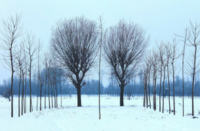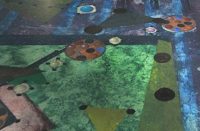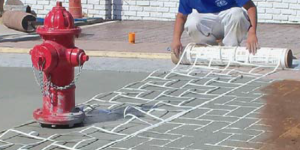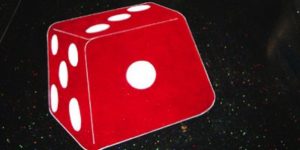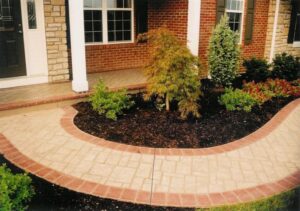Rachel Knigge moved quickly from the art and graphic design world into the concrete realm, and her influence continues to grow as she expands her company.
Knigge, pronounced kuh-NIG-gee, was born in Houston, Texas, and grew up in Waco, where she trained as a designer in commercial art and advertising. In 2001, she moved with her husband, child and a second child on the way to Bella Vista, Arkansas, and eventually got a job as marketing coordinator for Ameripolish, a company formed by her brother-in-law in 2005.
“Usually I worked for smaller companies as their marketing guru covering the design of all catalogs, instruction sheets and website design,” Knigge says. For Ameripolish, she handled all the design work. For its trade show booths, the company used concrete slabs with solid arcs and blocks of color on them, which Knigge says wasn’t very creative.
“I wanted to step outside the box,” she says. “I wanted to try something different. I knew about stencils and I was getting into the concrete industry and learning what there was to know about it and the color mediums that could be used.”
In 2009, Knigge, 31, began creating stencils, which has since become her expertise. Back then, she knew Ameripolish could purchase stencils but it wasn’t as cost effective as producing its own, so it purchased a machine for her to make them. “I was cutting them for customers who would ask for design work as a service we provided,” she recalls. “It evolved into a product line, but it was really intended to be just for trade shows. We never knew that word would spread. It got to the point I was cutting more designs than I was creating ads.”
Around 2009, when the economy began to falter, Ameripolish had two graphic designers including Knigge, but not enough work for both. That led to Knigge’s boss suggesting she go off on her own. So she bought some of the design equipment she had purchased for the company and set about building her own name.
Embarking on her own
Stencil work involves creating a design that can be systematically applied to a concrete floor in different colors and in different mediums, such as epoxies or polyurea. The stencils come with instructions that allow non-artists to apply them like the pros. “The whole goal is to provide customers with something that is a no-brainer, where the stencil creates the design,” Knigge says.
She was initially nervous about making the jump to her own company, because of her self-described “artist mentality.”
“I can make a company grow and market and brand a company. That’s something I’m really good at,” she says. “But running a company and
the daily ins and outs have been a challenge to overcome. Over the eight years since I’ve been doing this I’ve learned through trial and error.”
When her customers would request a stencil design, she would always say yes even if she hadn’t done that type of design before. She says she would break the design apart to try and figure out how to make it work. Over time, she managed to learn the best ways to pull things off. “For instance, if you’re using dye it immediately flashes and dries and you move to the next step, whereas a different color medium like epoxy or polyurea would take much longer.”
Initially, she says, she only knew how to apply stencils using Ameripolish dyes. That’s no longer the case, although solvent-based dyes are her preferred medium. She realized the importance of broadening the color mediums she was using, so she developed techniques for sandblasting stencils and using perforated printed designs with epoxy overlays, in which the design is sandwiched underneath clear epoxy.
“There are so many different techniques,” she says. “I try to find different solutions, whatever makes it easier for my customers,” to look good for their customers while saving them time and money.
Knigge says working with polyurea and the epoxies takes more time so users have to be patient. “I’m not known for my patience so it’s a challenge!” she says with a laugh. “But it appeals to me.”
Eager to work with precast concrete and also to use stenciling techniques to create inlaid designs, Knigge has been recently intrigued with and is researching a new product called a sugar print, an image made of a sugar compound printed onto cardboard stock, which is set into the precast item. The sugar retards the concrete from curing properly, so when the mold is released the surface looks like exposed pebbles you’d find in walkways.
Most of the time, companies hire Knigge to create stencil designs they’ll apply themselves, but she’s also available to help with installations if the design is particularly complicated. Her primary job, though, is creating stencils for designs her customers can’t create themselves.
From Aunties and brawls to diamonds and maps
One rewarding job that Knigge did last summer was an abstract turtle for the entryway of Echuca Regional Health, a new public hospital in the port town of Echuca-Moama, Australia. That job required a 2,000-square-foot i
nstallation to be done in less than three days. In this case, the client found Knigge through word of mouth, and the coordinator for the design researched and selected her.
The hospital, a two-and-a-half-hour drive north of Melbourne, featured stenciled artwork in the foyer. The original art was designed by an Aboriginal elder, respectfully called an “Auntie.” Some elements of the design continued around the edges of the large room and the walking areas.
“It was a really big honor,” Knigge says. “I got to meet several of the Aunties. It was like meeting the chief of the tribe but it was this Auntie and the Auntie above her and the Auntie above her. For them to be touched as much as they were by the design and how much it meant to them to have me transfer it in such a way that it was identical to what she wanted was very rewarding.”
Aboriginal art utilizes dots, straight and curved lines, and concentric circles that have deep symbolic meaning. In the Aboriginal belief system, each animal also holds a special meaning. “There are many elements in the design that all have meaning and tie together,” says Knigge. “It’s a very powerful statement.”
Another job Knigge designed but did not install was for the Porsche raceway next to the Atlanta airport. As planes fly in, passengers can see a huge red stripe that has white Porsche letters on it. “That’s my stencil. I created it!” Knigge says with enthusiasm.
In 2014, Knigge was a winner in the Concrete Decor Show’s first Brawl in the Fall decorative concrete artistry competition where she placed third for her rendition of a 3-D Rubik’s Cube she made from a stencil. The cube, which wowed judges and attendees in Fort Worth, Texas, appeared to be popping out of the floor while its bottom was melting into a puddle of combined colors. People took photos of themselves sitting or standing on the cube.
“I really enjoy working with that kind of stuff. They’re a lot of fun to do,” Knigge says, even though 3-D designs don’t sell very well because they’re so complicated to install. The Rubik’s Cube took seven layers of stencil and numerous individual pieces for each layer.
Late last year, a contractor hired her to install a map of the High Uintas Wilderness and the surrounding counties in Duchesne, Utah, near Salt Lake City. The 17-by-12-foot map includes all the rivers, reservoirs, main roads and other details for Duchesne County, with the roads 1/4 inch wide.
Branching out
In the opening episode of the History TV show “Pawn Stars,” Knigge helped Classic Coatings Systems install the gold leaf over black epoxy graphic for the show. Subsequently, that work is shown five or six times each episode.
The graphic artist is interested in exploring other areas of decorative concrete artwork such as custom inlay pieces for terrazzo flooring and digital floor graphics. She is considering purchasing a water jet machine to cut precise designs out of metal or stone.
“I want to start doing inlays and get into design solutions other than floor stencils,” says Knigge. For instance, with the new equipment, she can create detailed logos or images that can be inlaid into precast countertops.
Even though she’s embarking on work she hasn’t done before, she doesn’t doubt she can pull it off. “When I couldn’t figure out how to do something I would tenaciously dwell on it until I could,” she says. “One successful mishap after another ended up working in my favor.”
www.floormapsinc.com
